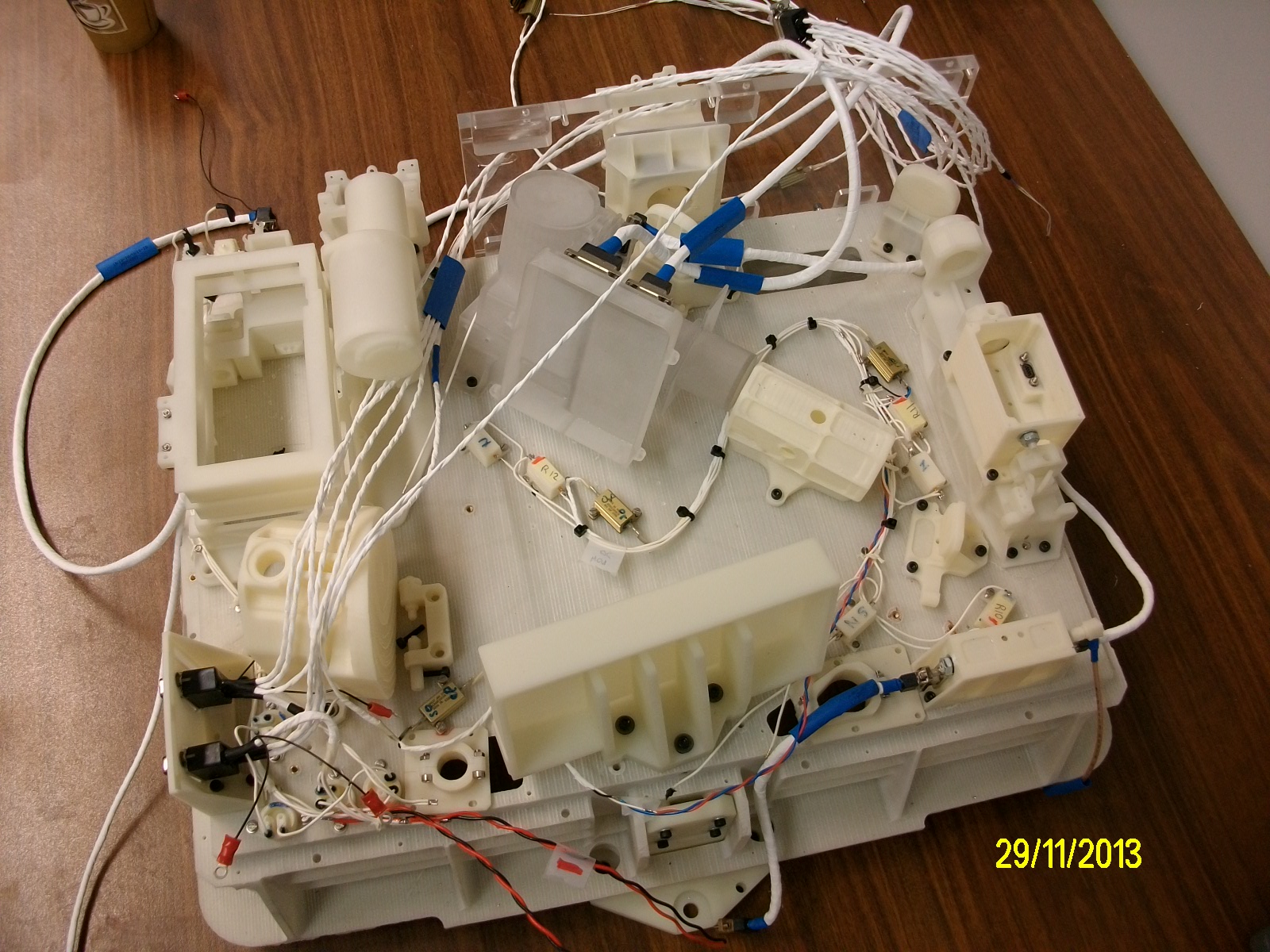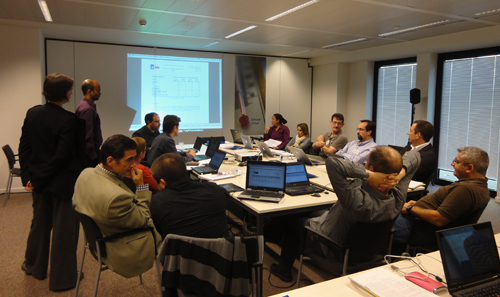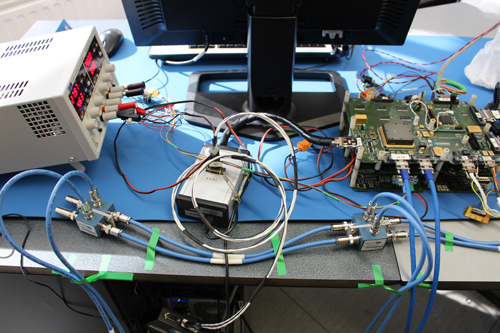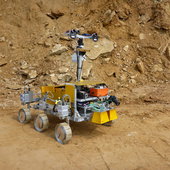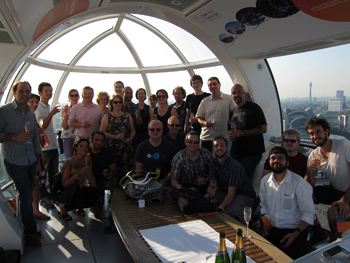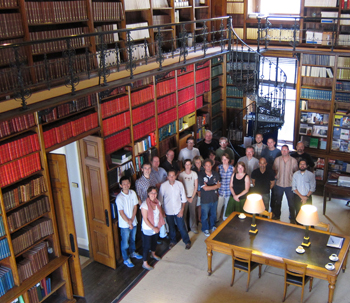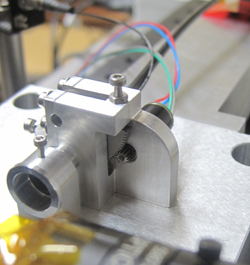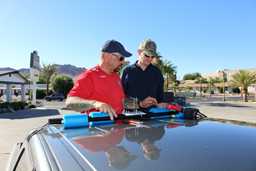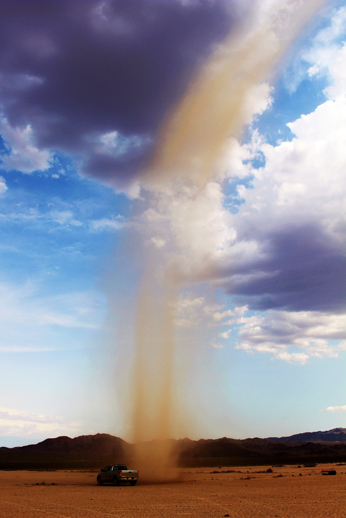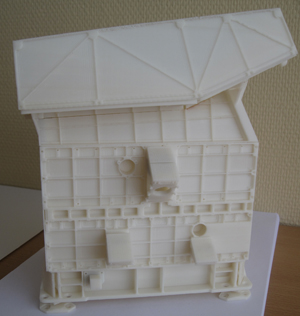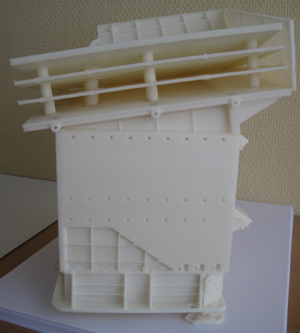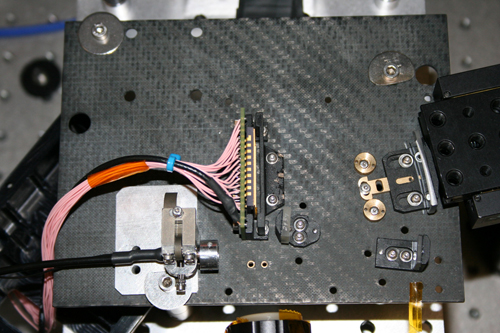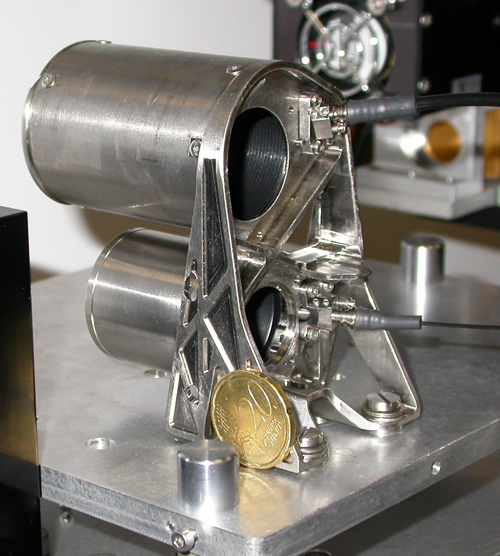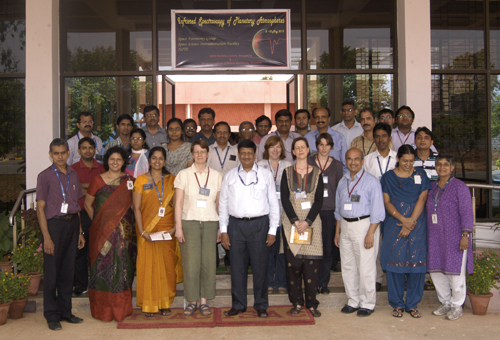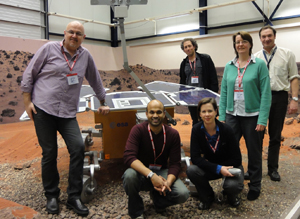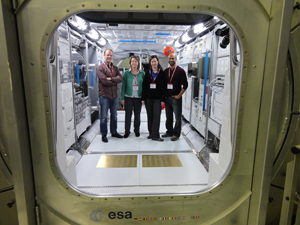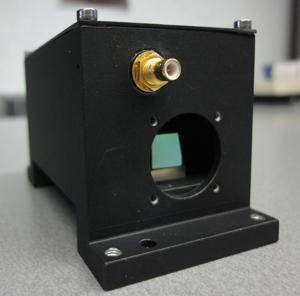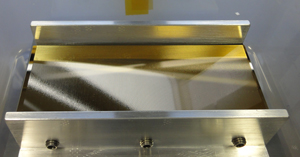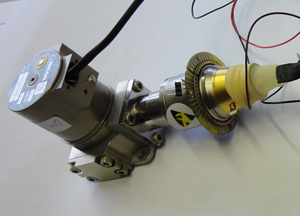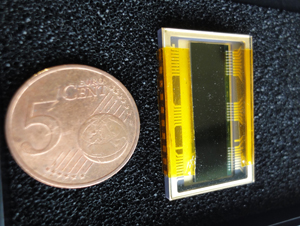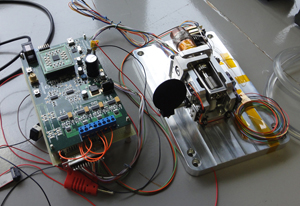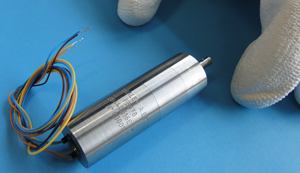 |
||||
|
Webstory: 2013 NOMAD and the spaghetti 6 December 2013: NOMAD's sinterklaas gift was a mock up of the channels, printed on a 3D printer by Glenair, UK. This printout serves as a basis to design the harnessing of NOMAD. This means all the electric cables that need to pass from the main computer to each electronic board, passing commands and sending back data. Space wiring is expensive as it must be light, reliable, and well insulated to prevent discharges and interfering signals from different channels. The wires also power heaters to keep the instrument warm during the long cruise from the Earth to Mars. This picture shows the layer of NOMAD that has the solar occultation infra-red channel and the UV-Vis instrument that performs nadir and occultation measurements.
There is a real 'spaghetti' of wires criss-crossing the instrument, colour coded and of varying thicknesses. The heater loops are attached tightly to the baseplate, and have redundant (spare) heaters in case any fail. The main electronics boxes are attached underneath the baseplate shown here. Belgium explores Mars 26 November 2013: NOMAD PI Ann Carine Vandaele gave a presentation at the British School of Brussels, organised by the Royal Society of Chemistry. Her talk on Exploring Mars was very well received, as this article shows... read more NOMAD holds its Critical Design Review 1-3 October 2013: NOMAD team members from Spain, the UK and Belgium gathered in Brussels to answer questions from the experts at ESA and TAS (Thales Alenia Space - the ExoMars TGO prime contractor). Hundreds of documents were submitted for review during July and August and 189 questions (Review Item Discrepancies) were raised. The three days were long and intense, covering all aspects of the instrument design. Most topics were resolved, and the NOMAD team now has 6 weeks of work to update documents to reflect the agreements. CDR marks the passage from phase C to D of the instrument development - meaning that manufacture of the flight model can officially now begin. In fact, given NOMAD's tight schedule, many flight parts have already been ordered. We took advantage of having our Spanish colleagues from IAA in Belgium to perform tests with an engineering model of SINBAD - NOMAD's 'computer'. All went well - it communicated with the mockup of our infrared channels here in Belgium, and was used to drive the stepper motor that will switch between nadir and occultation viewing in the LNO channel! Desert trial for ESA Mars rover 04 October 2013: Next week will see ESA’s most ambitious planetary rover test yet. Robotic exploration of a Mars-like desert in South America will be overseen from the UK, providing experience for future missions to the Red Planet.
More details on ESA Science website
Vibration Test 19 September 2013: After a successful Test Readiness Review with ESA, testing has begun on parts of the UVIS channel. The first was the vibration test of the selector mechanism, which allows NOMAD to select either solar or nadir viewing for the UV-Visible spectrometer. Images of the mechanism can be seen in the story from 13 August. Here is a video of it being shaken at various frequencies in the facilities at the Centre Spatiale de Liège. This is called a resonance search - it searches for any frequencies that provoke resonances in the mechanism. Resonances can cause larger than normal movement within a structure, and eventually cracks or breaks may occur. Since the entire instrument will vibrate at launch, a study of frequencies is very important. Sensors are mounted on the structure and a range of vibration frequencies are applied to it. Everything looks good so far......
NOMAD Science Working Team Meeting #5 4-6 September 2013: The fifth NOMAD science team meeting was held in London, UK at the beginning of September. 25 Co-Investigators from all over the world attended, with more participating via internet link. The UK Lead Co-I, Dr Manish Patel, and his team organised a busy social agenda, as well as the detailed workshop programme that covered technical updates on instrument development and scientific presentations by PhD students and more experienced researchers. There was also time for discussion on what NOMAD will achieve in the future. Here we see the team enjoying a lovely sunny September evening from the London Eye at Waterloo. Here we see the Royal Astronomical Society library, where books by Galileo, Newton and Herschel line the shelves... and the NOMAD team lines up for a photo during a tea break. Preparing to shake it up 13 August 2013: A pre- test readiness review was held at Lambda-X today with attendance from those involved in the development of the UVIS channel of NOMAD. We are preparing to perform vibration testing of the selector mechanism. This is a very important part of the UVIS channel as it selects which telescope (nadir or solar occultation) transfers its light to the UVIS spectrometer. Optical fibres run from the back of each telescope to either end of a pivot attached to a motor. The motor rotates such that one end of this pivot is placed at the entrance slit of the UVIS optical bench. In fact, the nadir channel has 19 fibres in a circle at the back of the telescope, that form into a vertical line at the slit, to maximise the signal. In solar occultation, there is plenty of signal, so one thin fibre is enough to illuminate the detector with a good signal to noise ratio. The alignment of the fibre(s) with the slit is very important to maximise the signal. This will be optimised, of course, but could change with launch vibrations. In order to check that the design is resistant to vibrations, this breadboard model will be vibrated at CSL facilities and the repeatability in the alignment of the fibres with the slit checked before and after. Dust devil chasing 4 July 2013: Three researchers (Manish Patel, Jon Mason and Tim Ringrose) from The Open University braved the extreme heat of the desert for two weeks to conduct field research on terrestrial dust devils in the Eldorado Valley, Nevada. The aim was to measure the wavelength-dependent attenuation of the solar spectrum caused by the lofted dust particles in order to test the dust retrieval algorithms that will be required for future NOMAD-UVIS data analysis. The instrumentation used in this study included two ultraviolet and visible spectrometers (similar to UVIS), a photodiode, a pressure sensor, a temperature sensor and high definition imaging cameras. The random nature of dust devil formation required our measuring platform to be mobile, thus the instruments were attached to the roof of a truck (as shown above). A game of ‘cat and mouse’ ensues with repeated attempts to chase down the dust devils and position the instruments in their path before they dissipate or move off the measurement area. An example of a dust devil encounter is shown in the following picture. The fieldwork was a great success, with lots of data collected similar to what NOMAD-UVIS will provide from ExoMars. Now the team will analyse the data in slightly cooler conditions. NOMAD 3D print out 1 July 2013: For a recent Open Day at the Institute of Space Aeronomy, our engineers printed a 3D model of NOMAD at one third scale. The Computer Aided Design model had to be simplified to reduce the time it would take to print, but the structures are all visible. This was printed in several pieces - the cryoradiator is separate and can be lifted off to expose the inside of the LNO channel. On the front, you can see the 3 periscopes that allow solar occultation viewing, as well as the holes for nadir observations. On the side, you can see the general radiator, that evacuates the heat from the SO and UVIS channels, and the electronics underneath. This 1/3rd scale model fits on an A4 sheet of paper easily, and weighs only a few hundred grams, compared to nearly 30kg for the real NOMAD instrument. ExoMars TGO satellite nears completion 18 June 2013: This breaking news story from the Paris Air Show about ExoMars TGO 2016. The satellite is almost finished, instruments (including NOMAD) must be delivered next year for spacecraft level testing, prior to January 2016 launch.
UVIS Breadboarding 24 May 2013 - UVIS breadboard photos! Below are two pictures of the UVIS instrument breadboarding activities. On the image on the left, we can see the spectrometer. The mass of pink cables are attached to the CCD detector, below which is the fibre optic input to the spectrometer. To the right of the image we see optical elements: mirrors and the grating. These are mounted on a carbon fibre plate, as will also be the case for the flight model. The right-hand photo shows the UVIS telescopes. The larger one is for nadir viewing, where the field of view is 43'. The smaller one is the solar occultation telescope, shown near a 20cent coin for scale. One can see fibre optic bundles leaving both telescopes - thin for the solar occultation and thicker for nadir. These breadboards will be used to test optical alignment at various temperatures, as well as to demonstrate straylight measurements and correction. NOMAD goes to India 6-10 May 2013 - NOMAD team members Ann Carine Vandaele, Rachel Drummond, Lori Neary and Séverine Robert participated in an Infra-red Spectroscopy for Planetary Atmospheres workshop in Bangalore, India. IASB-BIRA presented NOMAD, our radiative transfer code and GCM modelling activities. Indian researchers from various institutes presented work being carried out in India on many different planets, moons and instruments. We had very interesting, collaborative discussions with our new partners who are preparing a similar IR spectrometer for an Indian Mars mission. ExoMars has its own blog If you enjoy reading about NOMAD development activities, then you may also be interested in the ESA blog for ExoMars.
ESA and RosCosmos sign the agreement 14 March 2013 - ESA and RosCosmos have now finalised the agreement on their collaboration for ExoMars. The teams have already been working together for some time now, but top level decisions still needed to be ironed out. More details on ESA Science website
Official Science Working Team Pictures 20 February 2013 - The ExoMars SWT made it onto the ESA news pages today. Two official pictures were taken, you can find one by clicking on ESA and one by clicking on Roscosmos!
ExoMars Science Working Team Meeting # 5 (or #1) 18 February 2013 - 12-15 February a joint Rover-EDM-TGO (2016 and 2018 missions) meeting was held at ESTEC in the Netherlands. This is the 5th since ExoMars began, but the first with the new Russian instruments - i.e. the first since ExoMars became an ESA-RosCosmos endeavour. It was a great opportunity to hear about the new instruments and the development at the spacecraft level. Left to Right: Giancarlo Bellucci (lead co-I from Italy), Manish Patel (lead co-I from the UK), Ozgur Karetekin (ROB-ORM), Rachel Drummond (IASB-BIRA), PI Ann-Carine Vandaele (IASB-BIRA) and Andre Debus, the ESA point of contact for the NOMAD team. We are in the 'Mars Yard' at ESTEC where they test drive the rover for the 2018 mission. Eddy Neefs, Ann-Carine Vandaele and Rachel Drummond from IASB-BIRA and Manish Patel from the OU inside a model of the ESA ISS Colombus module.
Happy New Year ! 31 January 2013 - NOMAD has been taking deliveries this month. Many items of space hardware have long lead times (they take a long time to be made) and so must be ordered well in advance. For NOMAD this includes both the infra-red and ultraviolet detectors, the motor mechanism included in the LNO channel that needs special lubricants for space use, the AOTF crystals and their electronics (radio frequency generators) and the echelle gratings - that are diamond turned, then coated with gold. Some of the items we show here were ordered a year ago, as soon as the design was fixed. Now, they will be tested with other components to be sure they work as required. If not, there will be a lot of work to adapt the design, because getting new ones will be impossible before launch! So: here are the small but necessary pieces that were ordered so long ago. On the left is the AOTF - we can see the crystal through the entrance aperture. The box is black to minimise straylight issues. On the right is the gold coated engineering model of the echelle grating. Its holder is black, like the AOTF box, also to avoid straylight reflections. On the left, the Infra-red detector, with associated cooler pump. The detector entrance window is protected here by the cut-off finger of a laboratory glove! This is just an engineering model for tests. The flight models are kept in an ultra clean room, for protection. On the right, the UV CCD, which is far smaller. This is just an engineering model. The flight versions should arrive in July 2013. The flip mirror mechanism is shown on the left, with an example mirror mass attached and the electronics being tested to flip the mirror in and out of the light path. This is needed to swap from nadir viewing to solar occultation viewing. On the right is the first in a series of space-qualified motors that will be made by Thales. This is shown with the fingers of one of our engineers to give an idea of scale. News & press releases 2014 & 2015
|
|||
